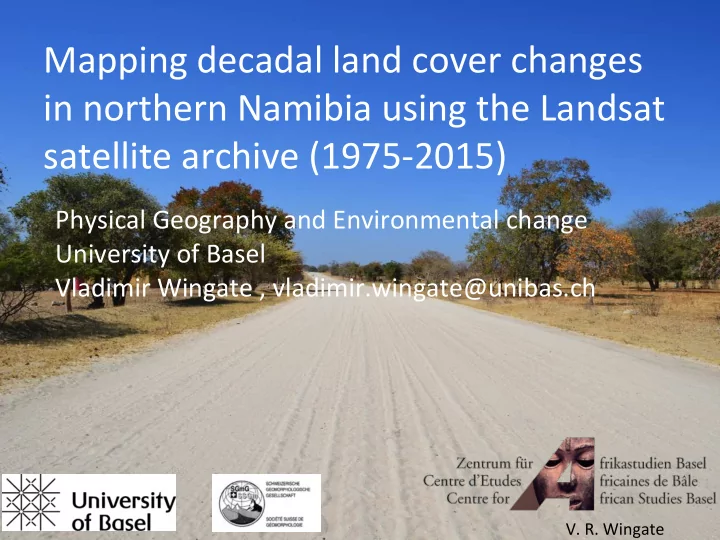

Mapping decadal land cover changes in northern Namibia using the Landsat satellite archive (1975-2015) Physical Geography and Environmental change University of Basel Vladimir Wingate , vladimir.wingate@unibas.ch V. R. Wingate 2014
Outline IntroducQon • – Study site and vegetaQon cover change in N Namibia – Landsat satellite data ObjecQves • – Assess the extent of vegetaQon cover change – i.e. deforestaQon, vegetaQon gain Method • – VegetaQon change mapping using the whole Landsat satellite archive – Landsat satellite image analysis tools IniQal results • – MulQ-temporal land cover class maps of vegetaQon cover change – Data on extent of loss and gain of forest cover Next steps • – Mapping fracQonal/percentage vegetaQon cover
Study site
northern Namibia • VegetaQon change – Human impact – Reduced savannah woodland – Expansion of arable land – Increased grazing • Expand on change work – Erkkilä et al. (2001) – Röder et al. (2014)
Landsat data • Landsat archive – Freely available, USGS – Local, regional, and global-scale analysis – VegetaQon change i.e. deforestaQon – Numerous applicaQons – 1972 – Present – RepeQQve, synopQc – High resoluQon (30x30m pixel)
ObjecQve • Map changes in land cover in N Namibia – Between 1975 and 2014 at decadal intervals – Emphasis on woodland/savannah cover change – Arable/agricultural land expansion V. R. Wingate 2014
Methods • Post-ClassificaQon method – Land cover is assigned to a class – Easily measure extent (i.e. ha, km2) – TransiQons between classes
Landsat archive analysis • Whole archive available for analysis: – Google’s earth engine – Select the best quality pixels for given period – Create a new best image – Classify new images into land cover classes for change analysis hfps://earthengine.google.com
IniQal results
IniQal results
Results and discussion
Results and discussion
Results and discussion • Land cover change between 1975-2014 – Over all decrease in woodland – Increase in arable land – Variable rates of change – Losses and gains – Small-scale conversion V. R. Wingate 2014
LimitaQons and further work • LimiaQons of post-classificaQon method – Difficult to produce consistent results – SubjecQvity introduced – operator judgements – Leads to erros – hard to replicate • Savannahs environments – Heterogenous land covers – Inter-intro annual variaQon – Shihs – fire, rainfall, grazing
FracQonal cover • QuanQtaQve analysis of the percentage cover (0-100%) of live vegetaQon, dry vegetaQon and exposed substrate for each satellite pixel – ecologically meaningful maps – idenQfy % forest cover – deforestaQon
Conclusion • Decrease in vegetaQon cover • Increase in arable land • Number of limitaQons with mapping methods • Especially true for savannahs environments • Probably resulQng in the variable results observed • Next pat of the study will explore the issue further using FracQonal Cover method
Recommend
More recommend